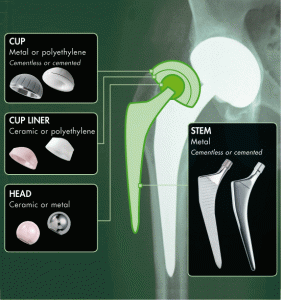What is a total hip replacement (THR) implant made from?

Total Hip Replacement implants
1. The acetabular components
The acetabular component of a total hip replacement generally comprises a shell and a liner. The shell is made of titanium niobium alloy and usually has a hydroxyapatite coating. The liner is either made from polyethylene plastic (ceramic or cobalt chrome on polyethylene bearing) or ceramic (ceramic on ceramic bearing).
As you would expect, every surgeon has their own preference for implants and materials. Dr Hutchinson always uses total hip replacement components that he considers to be the best for that individual patient. Great effort and research goes into understanding the performance of these devices to determine which is the most likely to give reliable and durable service.
Polyethylene
Polyethylene is the oldest and most commonly used material in hip replacement bearings (it is the only widely used option in knee replacement bearings). A polyethyene hip bearing comprises a ball made of metal or ceramic and a polyethylene socket. Prior to 2000 polyethylene was sterilized by a method of gamma irradiation in air. This led to the creation of free radicals in the material, which oxidized during storage resulting in poorer wear properties in vivo.
Modern polyethylene components are gas sterilized or irradiated in an oxygen-depleted environment and reheated creating crosslinking in the material, reducing free radicals thus mitigating oxidization and improving wear performance. The modern cross-linked polyethylene has been available since the year 2000 meaning that 10 to 15 year wear performance data is available. This data shows that the wear has been reduced by at least a factor of 10 when compared to the old polyethylene. Dr Hutchinson uses cross-linked polyethylene as a bearing material in patients who are unlikely to wear out this material in their lifetime.
Ceramic-on-ceramic bearings
The ‘ball’ (head-of-femur) and the lining of the acetabular ‘socket’ are both made from ceramic. Ceramic is an excellent material because it is particularly inert (the body doesn’t react to it) and has a very long safety record.
Zirconia toughened alumina (ZTA or biolox delta) is the ceramic of choice in modern hip replacements. The main advantage of ceramic is it wears out extremely slowly – around 100 times slower than old polyethylene bearing surfaces. It roughly doubles the cost of the hip implant (a cost the patient does not directly pay, it is borne by their health insurance). Thus it is considered in those who need their hip replacement to last more than 30 years. However ceramic bearings have their own unique complications. Very rarely they can shatter – the risk is thought to be in the order of 1 in 10 000 or more. If this occurs further surgery is needed.
Ceramic on ceramic bearings can occasionally make a squeaking noise. Generally this does not cause pain or functional limitation but can be an annoyance. The risk is small – around 2-3% of ceramic on ceramic hips squeak.
2. The femoral component
The femoral component of a total hip replacement generally comprises a stem, which is connected to a ball. In older patients (whose bone is more brittle) the stem may be connected to the femur with polymethylmethacrylate bone cement in which case the stem is usually made of stainless steel. In younger patients cementless fixation is used. Here the stem is made of a Titanium Niobium alloy with hydroxyapatite coating.
Titanium and hydroxyapatite stem
Titanium is the gold standard in cementless hip implants because it is strong, flexible and it is a particularly inert metal that does very well in the body. The stem is coated in a fine layer of hydroxyapatite. Hydroxyapatite is the main mineral in bone and when bound to the stem acts as a kind of fertilizer to enable the bone to rapidly grow onto and bind the stem.
How long do hip implants last?
The Australian Joint replacement registry gives an excellent guide to how long hip replacements done in the past are lasting today. Currently this registry shows that over 90% of hip replacements have lasted at least 15 years. How long a hip replacement will last varies depending on a patients age, activity level and weight. In the last 15 years there have been improvements in hip replacement technology, techniques and understanding. Not all “advances” have stood the test of time. Notably metal on metal hip replacements proved to be a retrograde step. However it is reasonable to expect hips replacements implanted today to take longer to “wear out” than in previous years